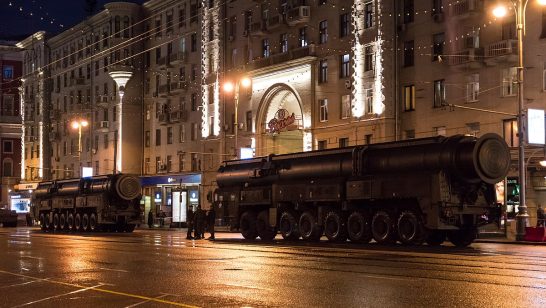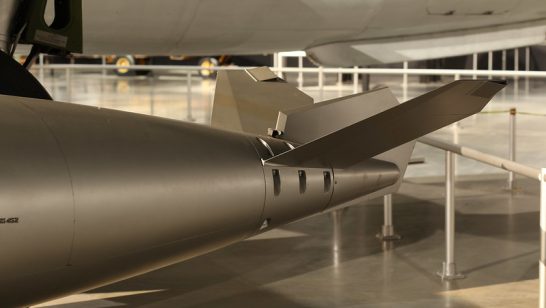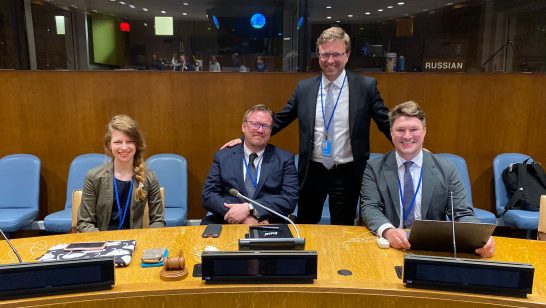
On 24th February 2022, Russia began its full-scale invasion of Ukraine. While the phenomenon of a stronger nuclear-armed state going to war with a less powerful non-nuclear armed state is far from unprecedented – even in the 21st century – the overt nuclear dimension to this conflict feels different to those in Afghanistan, Iraq, Georgia, Libya, and Syria, and even to the Russian annexation of Crimea in 2014. This is because nuclear threats, nuclear signalling, nuclear coercion, and nuclear deterrence have played a central role in how the conflict is playing out. None of the previous conflicts of the 21st century have included thinly veiled threats of nuclear use on this scale, and none of these conflicts involved such close interaction between nuclear-armed protagonists (Russia and, indirectly, NATO). While it is too early to draw meaningful and lasting lessons from the Russia-Ukraine war – at the time of writing, its future direction and possible conclusion are far from certain – it is nevertheless a useful time to reflect on the first conflict overtly involving nuclear weapons for a generation.
Nuclear threats, nuclear signalling, nuclear coercion, and nuclear deterrence have played a central role in how the conflict is playing out. Andrew Futter
1. Nuclear weapons are back as a major component of geopolitics, statecraft, and international relations.
This nuclear renaissance probably didn’t start in 2022, but we are moving into a world of multipolar nuclear competition centred on the US and its allies, Russia, China and, to a lesser extent, India. It is also a world where all nuclear-armed states are in the process of modernising, “recapitalising”, and in some cases, enhancing their nuclear capabilities. For a generation, nuclear politics scholars, professionals, and NGOs (especially in Europe) have predominantly focussed on nuclear security, nuclear terrorism, horizontal non-proliferation and disarmament. Today, this focus is shifting: deterrence, escalation management, strategic stability, risk reduction, and arms control are back as central challenges to the global nuclear order. This shift is perhaps most noticeable in the Euro-Atlantic as Western policymakers and publics are having to relearn the language and associated dangers of nuclear weapons, but it may only be a precursor to an arguably even more acute great power nuclear challenge in Asia between the US, its allies, and China over Taiwan. This suggests that, whether one believes that peace can only be attained in a nuclear-free world or that nuclear deterrence is the only viable way to ensure peace, the reality is that for the time being, nuclear weapons continue to play a significant role in international politics.
2. On balance, the nuclear taboo has probably been strengthened rather than undermined by the nuclear rhetoric and threats accompanying the Ukraine conflict.
Undoubtedly, thinly veiled Russian nuclear threats (including placing weapons “on alert”) created a perception that the normative taboo against nuclear use might be weakening, but the measured response to these threats from those supporting Ukraine and the widely assumed behind-the-scenes pressure from China and India on President Putin suggest that the Kremlin is aware of the cost of any type of nuclear use. NATO and other Ukrainian allies have been deliberately ambiguous in their responses, but Western signalling suggests the most likely reaction to even “limited” tactical nuclear use by Russian forces would be with conventional firepower and/or a massive ramping up of military support to Ukraine, rather than nuclear tit-for-tat. However, while widespread global sentiment may exist behind the norm of nuclear non-use, this doesn’t guarantee support for the West from the rest of the world regarding their objectives in Ukraine. Western nuclear norms are not automatically global nuclear norms.
3. Whether the Ukraine war represents success or failure of deterrence is multifaceted and depends on what and whom particular actors were and are trying to deter and how.
NATO and Ukraine failed to deter the Russian invasion – but Ukraine is not a member of NATO and not part of the extended nuclear deterrence guarantee at the heart of the alliance (the Budapest Memorandum contained only negative, not positive, assurances), and it is unclear whether the invasion was deterrable in case. President Putin was probably emboldened by Russia’s large nuclear stockpile to attack Ukraine, believing it would help to deter a direct response from NATO. However, Russia has also been deterred from escalating the war and attacking targets on NATO territory – deciding not to hit supply lines across the border in Poland, for example, that are crucial to the war effort. Notwithstanding US President Joe Biden’s warning of “Armageddon” that could ensue from Russian nuclear use, the decision by Moscow to keep the conflict geographically concentrated is likely the result of a fear of escalation to war against superior NATO conventional forces (it is less clear how the handful of NATO tactical nuclear weapons based in Europe factor into the Kremlin’s calculations). The Putin regime has arguably deterred direct NATO involvement in the conflict beyond providing considerable supplies of materiel and out-of-country training, by a mixture of official and unofficial nuclear threats and rhetoric. Albeit, there is no certainty that NATO would have established no-fly zones or sent military forces directly into Ukraine even without Russian nuclear capabilities and threats. What we can say is that credible deterrence involves being willing to pay a cost – both Russia and China will have drawn lessons from the ability of the West to endure the economic impact of supporting Ukraine. It also involves paying a longer-term fiscal cost of building and sustaining stockpiles of modern conventional military equipment for both deterrence and use.
4. There continues to be a misunderstanding about Ukraine “giving up” nuclear weapons after the fall of the Soviet Union in 1991, and this impacts views of the utility of nuclear weapons today.
Nuclear weapons infrastructure and delivery systems were left on Ukrainian soil after the Cold War, but these remained under Russian – not Ukrainian – control, and it is doubtful that the Ukrainian government could have operated them, let alone created its own independent “deterrent” (even if it wanted to). This historical inaccuracy has also fed the notion that Russian aggression would have been deterred had Ukraine been nuclear-armed. But again, the deterrent value of nuclear weapons is not clear cut – the possession of nuclear weapons (overt or otherwise) has not deterred conventional aggression in a number of other cases. Rather than a green light for would-be proliferators faced by a nuclear-armed adversary to “go nuclear” themselves, the takeaway might instead be that significant investment in advanced/strategic conventional weapons across the board and doubling down on alliances and, where applicable, extended (nuclear) deterrence guarantees are a more viable option for achieving security goals.
5. Perhaps the most contentious and worrying takeaway for Europeans (Indians, Pakistanis, Israelis, South Koreans and Taiwanese have known this for some time) is that conventional wars under the nuclear shadow are possible and that limited conflict involving a nuclear-armed protagonist(s) may be seen by some as viable and manageable.
This also seems to be where the Cold War era distinction between strategic and tactical/battlefield nuclear weapons is important. Notwithstanding some pre-war grandstanding about exotic Russian nuclear delivery systems and the destabilising impact of US/NATO ballistic missile defences, the NATO-Russia nuclear balance at the strategic level seems to be fairly stable. The same is probably true of the US-China strategic deterrence relationship. But what the Ukraine war has demonstrated is the belief – whether misplaced or not – in the utility of nuclear weapons and nuclear threats for coercion and use on the battlefield. This is being watched closely in Beijing, Islamabad, and Pyongyang and has fuelled debate in the US and NATO about new non-strategic nuclear capabilities (particularly a nuclear-armed submarine-launched cruise missile). However, as Western policymakers and strategists have discovered over the past 20 years, nuclear weapons don’t guarantee success in conventional warfare, and nuclear coercion may have a limited impact on a determined adversary. Conventional weapons (and support systems such as ISR) have been key to the day-to-day context of the war, and ultimately Russia has found that threats of nuclear use have had little impact on the Ukrainian willingness to fight or on the level of external support.
The conflict has brought an abrupt end to a certain nuclear complacency and apathy that has characterised European politics since the Cold War. Andrew Futter
NATO and the West have arguably emerged from the first year and a bit of the war looking stronger and more politically aligned than at any time for a generation, and the NATO nuclear deterrence mission has been given a new lease of life. This is almost certainly the reverse of what President Putin (and perhaps President Xi) had hoped for. But the conflict has also reignited a number of difficult questions and decisions for European policymakers and citizens. Not least, it has brought an abrupt end to a certain nuclear complacency and apathy that has characterised European politics since the Cold War. This shift will necessitate divisive political choices, not least the acceptance that the immediate challenge facing governments across the Euro-Atlantic space appears to be maintaining a credible nuclear and conventional deterrence capability and pursuing risk reduction and confidence-building measures rather than making significant steps towards disarmament. Maintaining the NATO deterrence posture could also – at least in the short term – involve signalling greater resolve and even higher spending on military forces in general, especially if one accepts that Russia is only one-half of the revisionist challenge facing the West. This, in turn, will require engaging European publics and making the case for a greater commitment to defence, including nuclear deterrence, in an era of significant economic pressures. This will be far from straightforward because it is not entirely clear whether evidence from the last 15 months of war strengthens or weakens the case for the continued possession of nuclear weapons by the US, UK, France, and NATO.
The opinions articulated above represent the views of the author(s) and do not necessarily reflect the position of the European Leadership Network or any of its members. The ELN’s aim is to encourage debates that will help develop Europe’s capacity to address the pressing foreign, defence, and security policy challenges of our time.
Image: Shutterstock



